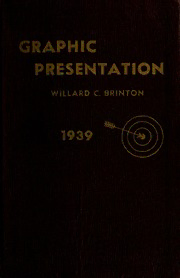
Graphic presentation PDF
Preview Graphic presentation
GRAPHIC PRESENTATION WILLARD 8RINTON C. %^ 1939 From the collection ofthe o Prepiger a ^ JUibrary P t San Francisco, California 2008 /$ a $.''>i''*^ C^-A <e. M Dedicated HONOR IN of WILLIAM PLAYFAIR FIRST EXPONENT OF GRAPHIC CHARTS FOR GENERAL USE Born at Benvie, Scotland, 1759 Died in London, England, 1823 DRAFTSMAN-ENGINEER With James Watt 1780 MANUFACTURER AUTHOR: THE COMMERCIAL AND POLITICAL ATLAS. 1st ed., 1786; 2nd ed., 1787; 3rd ed., 1801 TABLEAUX D'ARITHMETIQUE LINEAIRE DU COMMERCE, 1789 LINEAL ARITHMETIC, 1798 STATISTICAL BREVIARY, 1801 AN INQUIRY INTO THE PERMANENT CAUSES OF THE DECLINE AND FALL OF POWERFUL AND WEALTHY NATIONS. 1st ed, 1805; 2nd ed., 1807 STATISTICAL ACCOUNTOFTHEUNITEDSTATES OFAMERICA By D. F. DONNANT. Translated From the French By WILLIAM PLAYFAIR. Chart and Preface Also By WILLIAM PLAYFAIR. 1805 A LETTER ON OUR AGRICULTURAL DISTRESSES, 1st ed., 1821; 2nd ed., 1822; 3rd ed., 1822 CAN THIS CONTINUE?, 1822 The above titles by William Playfair are all, thus far located, which contain graphic charts. The total number of books by William Playfair is perhaps one hundred. — — TOPICAL INDEX (1st Half) ' Place rif^ht thumb on triangle, finders inside back covJer. Spin pa^es to desired chapter. — , 9-15 Preface 1- 16-23 1. Introduction 25- 32 2. Graphic Narrative 33- 42 3. Tabulation 43- 52 4. Classification Charts 53- 58 5. Geneology and Genetics Charts 59- 67 6. Organization Charts 68-72 7. Relationship Charts 73- 80 8. Flow Charts 81- 91 9. Sector Charts 92- 97 10. 100% Bar Charts 98-105 11. Comparison of 100% Bar Charts 106-114 12. Multiple Bar Charts 115-120 13. Contrasting Bar Charts 121-131 14. Pictorial Unit Bar Charts 132-141 15. Comparison of Component Bar Charts 142-148 16. Bilateral Bar Charts 149-152 17. Area Bar Charts 153-160 18. General Use of Maps 161-169 19. Guide and Route Maps 170-177 20. Relief and Aerial Maps 178-186 21. Crosshatched and Colored Maps 187-193 22. Dot and Pin Maps 194-199 23. Maps with Circles and Sector Charts 200-207 24. Maps with Bar Charts 208-210 25. Maps with Curve Charts 211-215 26. Maps with Symbols 216-230 27. Flow Maps 231-237 28. Contour Maps 238-242 29. Distorted Maps 243-246 30. Rating Charts (For 2nd Half of TOPICAL INDEX, See Page 247) MAGIC GRAPHS IN HERE is a magic in graph—s. The profile of a curve reveals in "J"Ja flash a whole situation the life history of an epidemic, a Mfelp^nic, or an era of prosperity. The curve informs the mind, awakens the imagination, convinces. Graphs carry the message home. A universal language, graphs convey information directly to the mind. Without complexity there is imaged to the eye a magnitude to be remembered. Words have wings, but graphs interpret. Graphs are pure quantity, stripped of verbal sham, reduced to dimension, vivid, unescapable. Graphs are all inclusive. No fact is too slight or too great to plot to a scale suited to the eye. Graphs may record the path of an ion or the orbit of the sun, the rise of a civilization, or the accelera- tion of a bullet, the climate of a century or the varying pressure of a heart beat, the growth of a business, or the nerve reactions of a child. The graphic art depicts magnitudes to the eye. It does more. It compels the seeing of relations. We may portray by simple graphic methods whole masses of intricate routine, the organization of an enterprise, or the plan of a campaign. Graphs serve as storm signals for the manager, statesman, engineer; as potent narratives for the actuary, statist, naturalist; and as forceful engines of research for science, technology and industry. They display results. They disclose new facts and laws. They reveal discov- eries as the bud unfolds the flower. The graphic language is modern. We are learning its alphabet. That it will develop a lexicon and a literature marvelous for its vividness and the variety of application is inevitable. Graphs are dynamic, dramatic. They may epitomize an epoch, each dot a fact, each slope an event, each curve a history. Wher- ever there are data to record, inferences to draw, or facts to tell, graphs furnish the unrivalled means whose power we are just be- ginning to realize and to apply. HENRY HUBBARD D. National Bureau of Standards Washington, D. C. GRAPHIC PRESENTATION By WILLARD COPE BRINTON, S. B. Consulting Engineer Member, American Society of Mechanical Engineers; Organizer and Chair- man, Joint Committee on Standards for Graphic Presentation, Formed 1914 Through Am.Soc.M.E., as Sponsor. Fellow, American Statistical Associa- tion; Vice President, 1919. Author Graphic Methods for Presenting Facta, 1914, McGraw-Hill Book Company, Inc. \\^^ ^VWx^. Q,, BRINTON ASSOCIATES New York City 1939 This book was planned with the hope of inspiring more and better factual presentation. If proper credits are given, any rea- sonable portion of this book may be quoted without further consent. However, to copy any materials here credited to others, care must be exercised to secure permission from the original sources. Copyright, Brinton Associates, 1939 First Edition Also by Willard C. Brinton GRAPHIC METHODS FOR PRESENTING FACTS. 1914 Published by McGraw-Hill Book Company, Inc. New York City Printed in the United States of America
